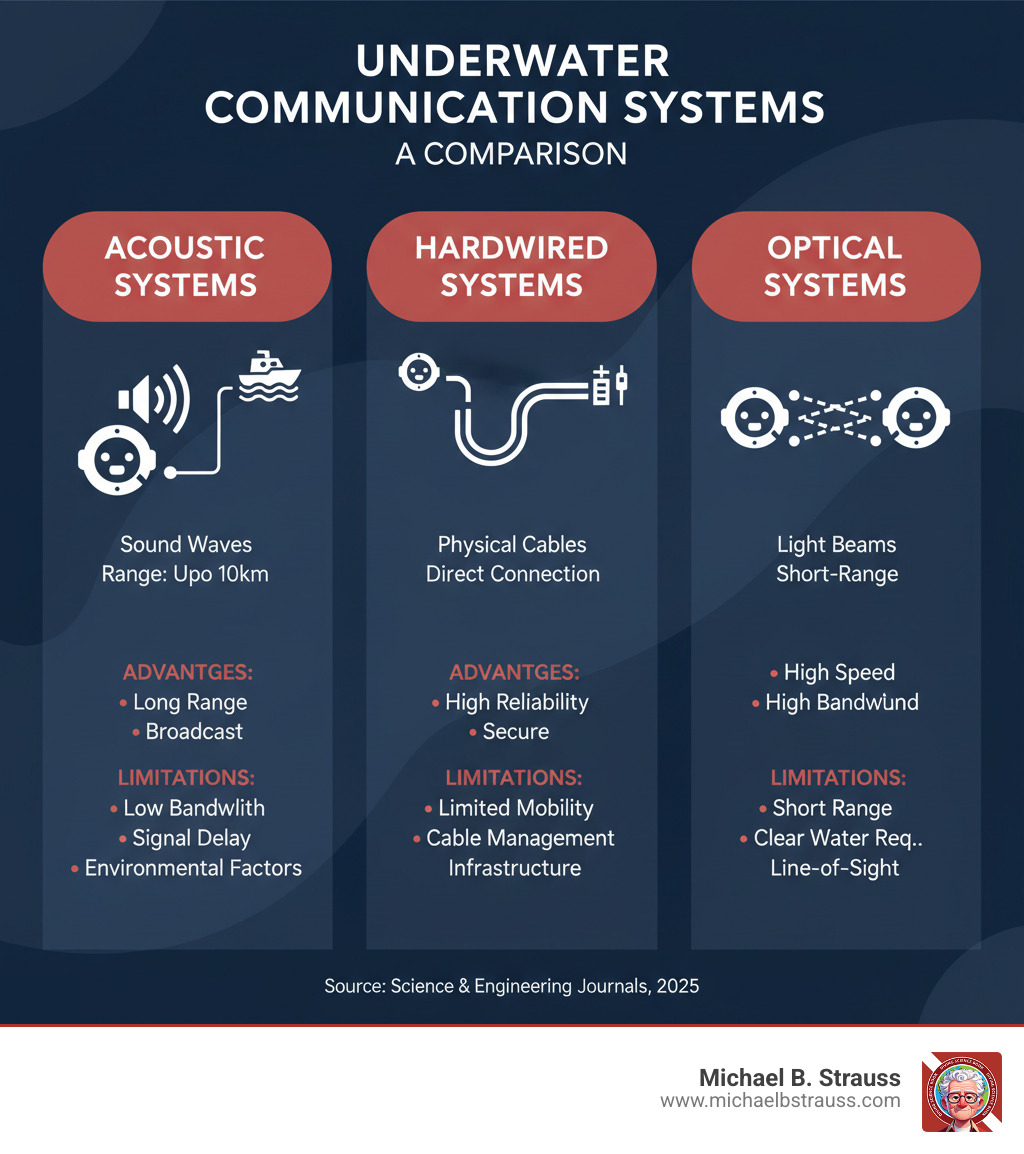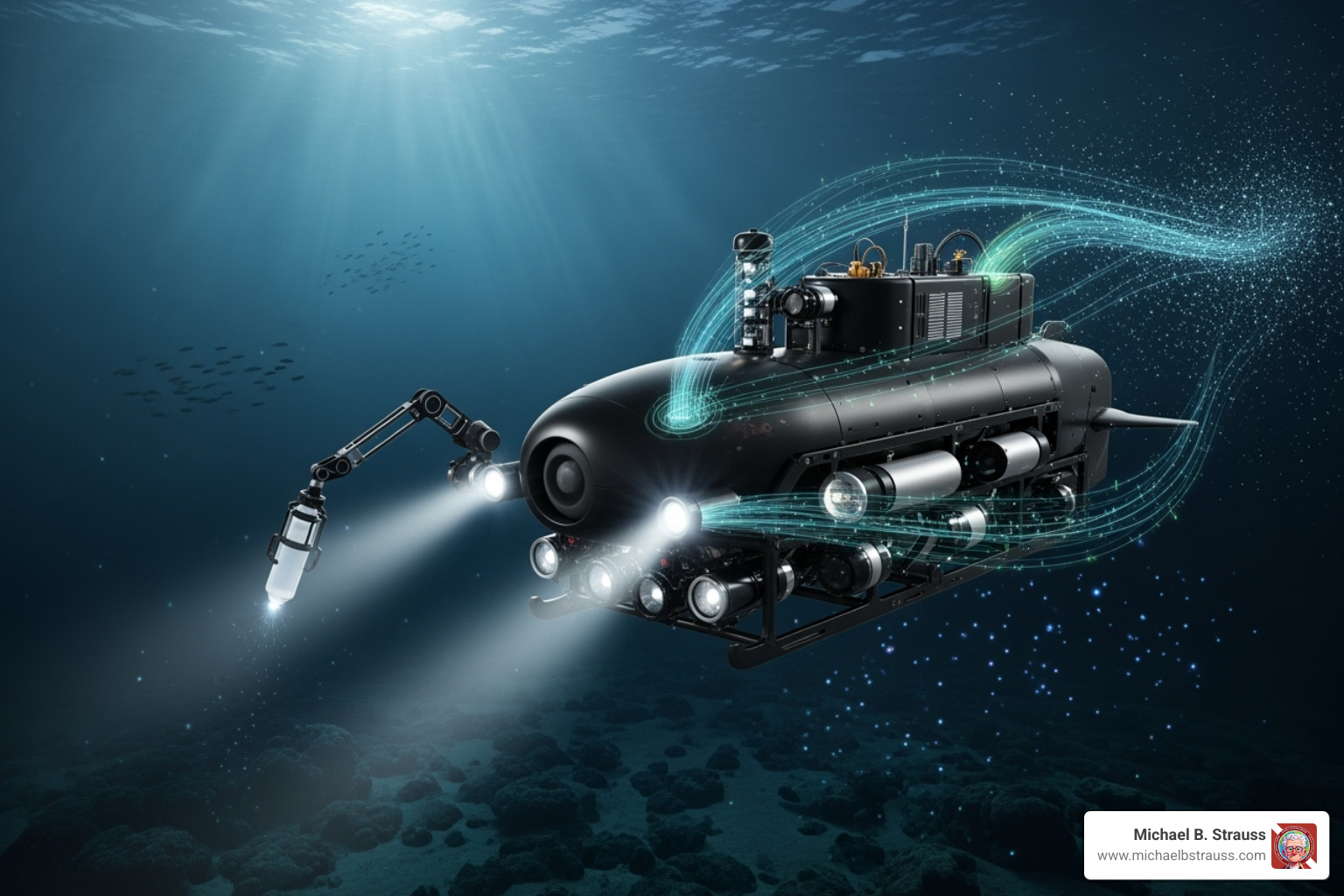Why Understanding Underwater Communication Matters for Divers and Medical Professionals
Underwater communication has evolved beyond traditional hand signals and tank banging. Modern technology enables real-time voice, data, and video transmission, revolutionizing diving safety, marine research, and underwater medicine.
Quick Overview: Main Types of Underwater Communication
- Acoustic Systems - Use sound waves to carry voice and data signals up to 10,000 meters
- Hardwired Systems - Physical cables connecting divers or equipment to surface stations
- Optical Systems - Light-based communication for high-speed, short-range data transfer
- Radio Frequency - Very low frequency (VLF) signals that can penetrate shallow water
The ocean, covering over 70% of our planet, is a challenging communication environment. Water's density and its property of blocking most radio frequencies necessitate specialized systems.
For medical professionals in diving medicine, hyperbaric treatment, or research, understanding these systems is crucial. They enable safer dives, better emergency responses, and effective data collection. Reliable communication is vital for a successful mission.
Since the first "Wet Phone" in 1977, technology has advanced significantly. Modern systems transmit clear voice, positioning data, and medical information between divers and surface teams.

The Science and Systems of Underwater Communication
The underwater world isn't as silent as you might think. Behind every successful dive operation and marine research expedition lies a sophisticated web of communication technology. Understanding how these systems work can be a matter of life and death for divers and is essential for anyone involved in underwater medicine or marine research.
An Overview of Primary Communication Methods
Underwater communication uses two main approaches: hardwired and wireless systems, each with specific use cases.
Hardwired systems connect devices like remotely operated vehicles (ROVs) to the surface with cables for power and data. These tethered systems offer high data rates and reliability, making them ideal for commercial diving's live video feeds and constant communication. The downside is limited mobility, as cables can tangle, restrict movement, and be costly over long distances.
Wireless systems provide freedom of movement using acoustic waves (sound), optical signals (light), or specialized radio frequencies.
- Acoustic communication is dominant, with ranges up to 10,000 meters. However, sound's slower speed results in lower data rates and delays.
- Optical communication uses blue-green light for fast data speeds, perfect for streaming HD video. The catch is that light is absorbed and scattered in water, limiting it to short ranges and clear conditions.
- Radio frequency communication struggles because water blocks most signals. However, very low frequency (VLF) radio waves can penetrate to about 20 meters, making them useful for specific applications like submarine communications.
The choice between hardwired and wireless often comes down to mobility versus maximum reliability and speed.
| Feature | Hardwired Communication | Wireless Communication (Acoustic) | Wireless Communication (Optical) | Wireless Communication (VLF/ELF RF) |
|---|---|---|---|---|
| Range | Very High (limited by cable length) | Medium to High (up to 10,000m) | Short (tens to hundreds of meters) | Medium to High (tens to hundreds of meters) |
| Data Rate | Very High | Low (kbps) | Very High (Gbps) | Very Low (bits/sec) |
| Mobility | Limited | High | High | High |
| Reliability | Very High | Medium (affected by environment) | Medium (affected by clarity) | Medium (affected by power/antenna) |
| Applications | ROVs, Commercial Diving | AUVs, Diver Comms, Sensor Nets | High-speed data links (short) | Submarine Comms (deep) |
| Complexity | Physical cable management | Signal processing, environmental factors | Alignment, water clarity | Large antennas, high power |
The Physics of Underwater Acoustic Communication
The physics of underwater communication explains why sound, not radio waves, is the primary medium. Seawater's high electrical conductivity blocks most electromagnetic waves, like radio and Wi-Fi signals. In contrast, sound waves travel efficiently through water due to its high density.
However, challenges exist. Sound travels at about 1,500 m/s in water, much slower than radio waves, causing significant delays that can be critical in emergencies. A major challenge is multipath propagation, where sound waves reflect off the surface, seafloor, and obstacles. These echoes arrive at different times, scrambling the signal.
Environmental factors like water depth and salinity also affect sound travel. Temperature gradients, or thermoclines, are particularly impactful. These layers can bend sound waves, creating "shadow zones" where communication is blocked.
How sound is used to communicate underwater?

Key System Components and Modulation Techniques
Specialized hardware is required for underwater communication. Key components include transceivers (transmitter/receiver), transducers (convert electrical to sound signals and vice versa), hydrophones (underwater microphones), and acoustic modems (convert digital data to acoustic signals).
The process of encoding data onto sound waves is called modulation. Early methods like Frequency-Shift Keying (FSK) and Phase-Shift Keying (PSK) struggled with echoes and distortion. A breakthrough came with Orthogonal Frequency-Division Multiplexing (OFDM), which splits data into multiple streams, making it highly resilient to multipath reflections.
A fundamental trade-off persists: higher data rates correspond to shorter ranges, while lower data rates achieve longer distances.
More info about Decompression Science
Major Applications: From Recreation to Research
Underwater communication has transformed how we operate beneath the waves.
- Recreational Diving: Systems in full-face masks allow clear voice communication, improving safety by enabling immediate problem reporting and coordination. Instructors can provide real-time feedback.
- Scientific Research: The technology is vital for data collection. Autonomous Underwater Vehicles (AUVs) use acoustic modems to transmit data, while seafloor sensor networks monitor environmental parameters for climate and pollution studies.
- Military and Defense: Applications include submarine communication using VLF radio waves, acoustic surveillance networks, and mine detection systems.
- Commercial Sector: The oil and gas industry uses these systems to monitor infrastructure, control ROVs, and ensure diver safety. Aquaculture uses them for autonomous robots that monitor fish health and farm infrastructure.

Challenges and Security in Underwater Communication
Underwater communication faces unique and persistent obstacles. Bandwidth limitations restrict data rates and create high latency (delays). Environmental noise from marine life, shipping, and waves leads to reliability issues like signal fading and distortion from the Doppler effect.
Security is another concern. The open nature of acoustic signals makes them vulnerable to eavesdropping and intentional jamming. Developing robust security measures for underwater channels is complex, as standard techniques are often ineffective.
More info about Mammalian Divers
The Next Wave: Future Trends in Subsea Tech
The future of underwater communication is promising, with several exciting developments.
Standardization is a key trend. The JANUS protocol, approved by NATO in 2017, creates a universal standard that enables interoperability between different manufacturers' devices, similar to Wi-Fi.
A new era of digital underwater communications
Optical Wireless Communication (UWOC) offers the potential for gigabit-per-second data rates, ideal for high-bandwidth, short-range applications like streaming HD video, though it requires clear water.
The integration of smartphone technology is making underwater communication more accessible. Apps on phones in waterproof cases can now send acoustic messages, a boon for recreational divers.
The Internet of Underwater Things (IoUT) is a vision for a vast network of connected sensors and vehicles providing real-time data on ocean health.
AI and Machine Learning are being used to tackle challenges like environmental noise through advanced signal denoising and adaptive modulation, making systems more robust and efficient.

Conclusion: Connecting the Depths Safely
The evolution from simple hand signals to digital conversations marks a significant leap in underwater communication technology. We've seen how water's physics dictates communication methods, making sound the primary medium despite challenges like multipath reflections and thermoclines.
Impressive solutions include resilient acoustic modems, reliable hardwired systems, and high-speed optical communication for shorter ranges. This technology is about safety and findy. It allows divers to call for help and enables scientists to monitor marine ecosystems in real-time. Applications are widespread, from military and commercial diving to scientific research.
The future is promising, with standardization like the JANUS protocol, smartphone integration, the Internet of Underwater Things, and AI-driven systems making communication smarter and more accessible.
These advances align with Dr. Michael B. Strauss's dedication to diving safety through education. Understanding how underwater communication works—its capabilities and limitations—makes every diver safer and more effective. Whether you're planning your first reef dive or leading a scientific expedition, knowing these systems can improve both safety and success.
The once-silent world is now connected. As technology evolves, our ability to explore, understand, and protect the underwater field will only increase.
Learn more about the science of diving
To dive deeper into this topic, get the book Diving Science Revisited.
DISCLAIMER: Articles are for "EDUCATIONAL PURPOSES ONLY", not to be considered advice or recommendations.






